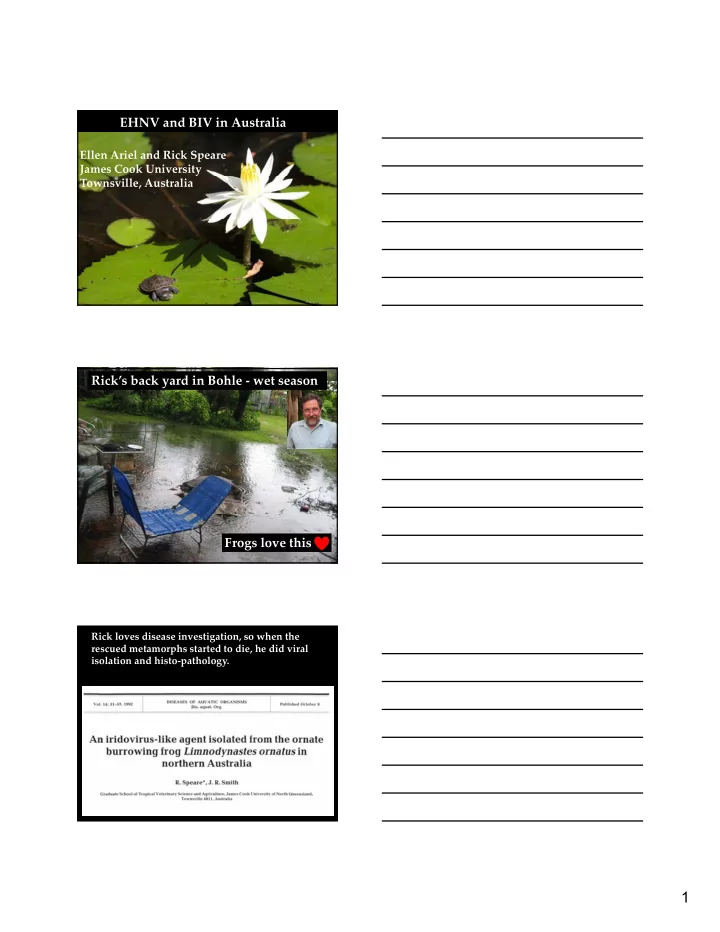

EHNV and BIV in Australia Ellen Ariel and Rick Speare James Cook University Townsville, Australia Rick’s back yard in Bohle ‐ wet season Picture of Tvlle in wet season Frogs love this Rick loves disease investigation, so when the Bohle iridovirus (BIV) rescued metamorphs started to die, he did viral isolation and histo ‐ pathology. 1
Denmark PhD Aquatic Pathobiology ‐ ranavirus Ellen Ariel Associate Professor Virology Veterinary and Biomedical Sciences Human Viral Diseases Aquatic Epidemiology Community Reference Lab for Fish Diseases EHNV and BIV in Australia Bohle iridovirus BIV 2012 Python 1998 BIV 1989 EHNV 1987 Epizootic Haematopoietic Necrosis virus OIE (World Animal Health Organisation) has listed EHNV as a notifiable disease in fish and ranavirus in amphibians 2
OIE (World Animal Health Organisation) reference laboratory for EHNV and ranavirus is based in Australia Dr Nick Moody Dr Richard Whittington Australian Animal Health University of Sydney Laboratory Faculty of Veterinary Science Geelong Victoria 3220 Camden NSW 2570 AUSTRALIA AUSTRALIA Email: nick.moody@csiro.au Email: richardw@camden.usyd.edu.au Leigh Owens Challenge trials Jeremy Langdon 1989 EHNV trials 11 teleosts BIV trials Student projects: fish, crustaceans amphibians and reptiles Moody 1994 Barramundi Cullen 1995 Frogs Joy Becker 2013 Ariel 1997 Tilapia EHNV trials Ariel 2015 Crocodiles, 12 freshwater fish spp snakes and turtles Challenge trials EHNV In addition to redfin perch ( Perca fluviatilis ) and rainbow trout ( Onchorhyncus mykiss ), the original hosts for EHNV, several species of freshwater fish were found to be susceptible: Langdon 1989 Macquarie perch ( Macquaria australasica) , silver perch ( Bidyanus bidyanus) , mountain galaxias ( Galaxias olidus) and mosquito fish ( Gambusia affinis). Becker et al 2013 Murray ‐ Darling rainbowfish ( Melanotaenia fluviatilis), Dewfish ( Tandanus tandanus), Eastern mosquitofish ( Gambusia holbrooki), Silver Perch ( Bidyanus Bidyanus) and Macquarie Perch ( Macquaria australasica) While others appeared to be refractory or with low mortality 3
Challenge trials BIV Amphibians: Bufo marinus and a range of native species ( Limnodynastes, Litoria, Pseudophrenye, Taudactylus ) could be infected with BIV, but mortality variable (Cullen et al 1995; Cullen & Owens 2002) Fish: mortality in barramundi ( Lates calcarifer ); infect tilapia ( Oreochromis mossambicus ) (Moody & Owens 1994; Ariel & Owens 1997) Reptiles: kill tortoise hatchlings (Ariel 1997) – Elseya latisternum & Emydura krefftii Juveniles more susceptible Host susceptibility to disease • Important to distinguish between infection versus disease • Susceptibility to disease depends on life stage – > for larvae and metamorphs, low for adults • The susceptibility depends on host species • Susceptibility is not predictable from host taxonomy Bioassay for virus refractory to cell culture Enveloped virus Naked virus Barramundi live Barramundi dead Tilapia live Tilapia dead 4
Bioassay for virus refractory to cell culture 1. 2. 3. 4. Pathology “ Apparent tropism for vascular endothelium and widespread multi ‐ organ necrosis and/or haemorrhage, especially involving haematopoietic tissues.” Richard Whittington EHNV in fish Reddacliff and Whittington 1996 BIV in frogs Jerret et al 2015 BIV in turtles Ariel et al 2015 Kidney with necrosis of haemopoetic tissue 5
Kidney with necrosis of glomerular mesangium Jerret et al 2015 Liver with necrosis • Pathology is usually extensive in fatal cases • Many organs damaged Basophilic inclusion bodies liver Jerret et al 2015 6
Antigen of BIV can be detected by IHC Jerret et al 2015 Stomach submucosa – venular epithelium labelled Jerret et al 2015 Ranavirus pathology • Widespread focal necrosis in many organs ± haemorrhage • Animals die from “organ failure”, but pathophysiology is not understood Makes treatment difficult! 7
EM and Molecular Alex Hyatt Molecular Epidemiology distribution and factors influencing susceptibility in specified populations 8
Distribution of anti-ranaviral antibodies in introduced Bufo marinus MHRV Overall prevalence 2.7% Regional range BIV 0-13% Ranavirus antibodies common in freshwater turtles & freshwater Zupanovic et al 1998 crocodiles in NQld Epidemiology EHNV • EHNV is poorly infective but highly virulent in rainbow trout • may be found in trout in all age classes • need not be associated with clinically detectable disease in the population • can be transferred with shipments of live fish • can be detected in a small proportion of 'routine' mortalities • may be associated with specific antibodies in a small proportion of older fish Epidemiology EHNV • The origins of the virus are unknown • means of spread may include the intentional movement of live or dead fish • the mechanical transfer on boats, nets and other equipment • spread through flowing water • migrating carrier fish in a catchment New South Wales Victoria area South Australia • potentially, mechanically by piscivorous birds 9
Epidemiology temperature Does temperature influence the distribution of EHNV and BIV? Epidemiology temperature Pathogen Virulence Temperature preference Host target Disease Host Susceptibility Environmental Immune competence factors Nutrition / reproduction status Season General health Water temperature Water quality Food availability Predation stress Co ‐ infections • Recent hypotheses that ranaviruses may be devastating to amphibian populations already compromised by endemic chytridiomycosis. • The impact of these two pathogens (and others) certainly needs more clarification in a range of environments and populations. 10
Epidemiology is dynamic • Epidemiology / ecology is complex • Multiple hosts of different susceptibilities interacting with local environment • Environmental persistence of pathogen and role for acquired immunity • Global trade in ornamentals is probably a huge facilitator of spread Disinfection and Prevention OIE guidelines for surveillance and prevention of spread Field hygiene protocols Speare et al 2004 Research into disinfection methods 11
Biological control weapon? LO = Limnodynastes ornatus ; BM = Bufo marinus Mortality variable in adult toads Biological control weapon against invasive cane toads? … and what is next? 12
Thanks for listening ‐ references on line 13
Recommend
More recommend